+ Open data
Open data
- Basic information
Basic information
| Entry | Database: PDB / ID: 6jwi | ||||||||||||
|---|---|---|---|---|---|---|---|---|---|---|---|---|---|
| Title | Yeast Npl4 in complex with Lys48-linked diubiquitin | ||||||||||||
 Components Components |
| ||||||||||||
 Keywords Keywords |  PROTEIN BINDING / PROTEIN BINDING /  UBIQUITIN UBIQUITIN | ||||||||||||
| Function / homology |  Function and homology information Function and homology information translation at postsynapse / APC/C:Cdc20 mediated degradation of Cyclin B / SCF-beta-TrCP mediated degradation of Emi1 / APC-Cdc20 mediated degradation of Nek2A / Formation of a pool of free 40S subunits / ER Quality Control Compartment (ERQC) / Regulation of PTEN localization / Downregulation of ERBB2:ERBB3 signaling / SMAD2/SMAD3:SMAD4 heterotrimer regulates transcription / IRAK2 mediated activation of TAK1 complex ... translation at postsynapse / APC/C:Cdc20 mediated degradation of Cyclin B / SCF-beta-TrCP mediated degradation of Emi1 / APC-Cdc20 mediated degradation of Nek2A / Formation of a pool of free 40S subunits / ER Quality Control Compartment (ERQC) / Regulation of PTEN localization / Downregulation of ERBB2:ERBB3 signaling / SMAD2/SMAD3:SMAD4 heterotrimer regulates transcription / IRAK2 mediated activation of TAK1 complex ... translation at postsynapse / APC/C:Cdc20 mediated degradation of Cyclin B / SCF-beta-TrCP mediated degradation of Emi1 / APC-Cdc20 mediated degradation of Nek2A / Formation of a pool of free 40S subunits / ER Quality Control Compartment (ERQC) / Regulation of PTEN localization / Downregulation of ERBB2:ERBB3 signaling / SMAD2/SMAD3:SMAD4 heterotrimer regulates transcription / IRAK2 mediated activation of TAK1 complex / Negative regulation of FLT3 / SRP-dependent cotranslational protein targeting to membrane / PTK6 Regulates RTKs and Their Effectors AKT1 and DOK1 / Regulation of expression of SLITs and ROBOs / Gap-filling DNA repair synthesis and ligation in GG-NER / Fanconi Anemia Pathway / Major pathway of rRNA processing in the nucleolus and cytosol / Endosomal Sorting Complex Required For Transport (ESCRT) / Downregulation of TGF-beta receptor signaling / TGF-beta receptor signaling in EMT (epithelial to mesenchymal transition) / Synthesis of active ubiquitin: roles of E1 and E2 enzymes / IRAK1 recruits IKK complex / IRAK1 recruits IKK complex upon TLR7/8 or 9 stimulation / Nonsense Mediated Decay (NMD) independent of the Exon Junction Complex (EJC) / Downregulation of ERBB4 signaling / E3 ubiquitin ligases ubiquitinate target proteins / Alpha-protein kinase 1 signaling pathway / Stabilization of p53 / NOTCH3 Activation and Transmission of Signal to the Nucleus / Negative regulators of DDX58/IFIH1 signaling / Pexophagy / Regulation of NF-kappa B signaling / Cdc48p-Npl4p-Vms1p AAA ATPase complex / JNK (c-Jun kinases) phosphorylation and activation mediated by activated human TAK1 / Translesion synthesis by REV1 / Downregulation of SMAD2/3:SMAD4 transcriptional activity / Negative regulation of FGFR3 signaling / Negative regulation of FGFR4 signaling / Translesion synthesis by POLK / Nonsense Mediated Decay (NMD) enhanced by the Exon Junction Complex (EJC) / Negative regulation of FGFR1 signaling / Negative regulation of FGFR2 signaling / Regulation of TP53 Activity through Methylation / TRAF6-mediated induction of TAK1 complex within TLR4 complex / IRAK2 mediated activation of TAK1 complex upon TLR7/8 or 9 stimulation / translation at postsynapse / APC/C:Cdc20 mediated degradation of Cyclin B / SCF-beta-TrCP mediated degradation of Emi1 / APC-Cdc20 mediated degradation of Nek2A / Formation of a pool of free 40S subunits / ER Quality Control Compartment (ERQC) / Regulation of PTEN localization / Downregulation of ERBB2:ERBB3 signaling / SMAD2/SMAD3:SMAD4 heterotrimer regulates transcription / IRAK2 mediated activation of TAK1 complex / Negative regulation of FLT3 / SRP-dependent cotranslational protein targeting to membrane / PTK6 Regulates RTKs and Their Effectors AKT1 and DOK1 / Regulation of expression of SLITs and ROBOs / Gap-filling DNA repair synthesis and ligation in GG-NER / Fanconi Anemia Pathway / Major pathway of rRNA processing in the nucleolus and cytosol / Endosomal Sorting Complex Required For Transport (ESCRT) / Downregulation of TGF-beta receptor signaling / TGF-beta receptor signaling in EMT (epithelial to mesenchymal transition) / Synthesis of active ubiquitin: roles of E1 and E2 enzymes / IRAK1 recruits IKK complex / IRAK1 recruits IKK complex upon TLR7/8 or 9 stimulation / Nonsense Mediated Decay (NMD) independent of the Exon Junction Complex (EJC) / Downregulation of ERBB4 signaling / E3 ubiquitin ligases ubiquitinate target proteins / Alpha-protein kinase 1 signaling pathway / Stabilization of p53 / NOTCH3 Activation and Transmission of Signal to the Nucleus / Negative regulators of DDX58/IFIH1 signaling / Pexophagy / Regulation of NF-kappa B signaling / Cdc48p-Npl4p-Vms1p AAA ATPase complex / JNK (c-Jun kinases) phosphorylation and activation mediated by activated human TAK1 / Translesion synthesis by REV1 / Downregulation of SMAD2/3:SMAD4 transcriptional activity / Negative regulation of FGFR3 signaling / Negative regulation of FGFR4 signaling / Translesion synthesis by POLK / Nonsense Mediated Decay (NMD) enhanced by the Exon Junction Complex (EJC) / Negative regulation of FGFR1 signaling / Negative regulation of FGFR2 signaling / Regulation of TP53 Activity through Methylation / TRAF6-mediated induction of TAK1 complex within TLR4 complex / IRAK2 mediated activation of TAK1 complex upon TLR7/8 or 9 stimulation /  Regulation of BACH1 activity / Doa10p ubiquitin ligase complex / NRIF signals cell death from the nucleus / Translesion synthesis by POLI / Recognition of DNA damage by PCNA-containing replication complex / p75NTR recruits signalling complexes / HDR through Homologous Recombination (HRR) / Interferon alpha/beta signaling / Regulation of innate immune responses to cytosolic DNA / Negative regulation of MAPK pathway / Spry regulation of FGF signaling / Regulation of TP53 Degradation / Translesion Synthesis by POLH / Activated NOTCH1 Transmits Signal to the Nucleus / PINK1-PRKN Mediated Mitophagy / DNA Damage Recognition in GG-NER / Formation of TC-NER Pre-Incision Complex / Negative regulation of MET activity / Autodegradation of Cdh1 by Cdh1:APC/C / APC/C:Cdc20 mediated degradation of Securin / Termination of translesion DNA synthesis / Ubiquitin Mediated Degradation of Phosphorylated Cdc25A / Ubiquitin-dependent degradation of Cyclin D / Activation of IRF3, IRF7 mediated by TBK1, IKKε (IKBKE) / Inactivation of CSF3 (G-CSF) signaling / DNA replication termination / Senescence-Associated Secretory Phenotype (SASP) / AUF1 (hnRNP D0) binds and destabilizes mRNA / TNFR1-induced NF-kappa-B signaling pathway / Josephin domain DUBs / Dual Incision in GG-NER / Downregulation of ERBB2 signaling / Regulation of FZD by ubiquitination / Dual incision in TC-NER / IKK complex recruitment mediated by RIP1 / KEAP1-NFE2L2 pathway / Cdc20:Phospho-APC/C mediated degradation of Cyclin A / SCF(Skp2)-mediated degradation of p27/p21 / Oncogene Induced Senescence / Assembly of the pre-replicative complex / CDK-mediated phosphorylation and removal of Cdc6 / : / TCF dependent signaling in response to WNT / N-glycan trimming in the ER and Calnexin/Calreticulin cycle / Formation of Incision Complex in GG-NER / Metalloprotease DUBs / Gap-filling DNA repair synthesis and ligation in TC-NER / Degradation of AXIN / Regulation of TNFR1 signaling / Regulation of BACH1 activity / Doa10p ubiquitin ligase complex / NRIF signals cell death from the nucleus / Translesion synthesis by POLI / Recognition of DNA damage by PCNA-containing replication complex / p75NTR recruits signalling complexes / HDR through Homologous Recombination (HRR) / Interferon alpha/beta signaling / Regulation of innate immune responses to cytosolic DNA / Negative regulation of MAPK pathway / Spry regulation of FGF signaling / Regulation of TP53 Degradation / Translesion Synthesis by POLH / Activated NOTCH1 Transmits Signal to the Nucleus / PINK1-PRKN Mediated Mitophagy / DNA Damage Recognition in GG-NER / Formation of TC-NER Pre-Incision Complex / Negative regulation of MET activity / Autodegradation of Cdh1 by Cdh1:APC/C / APC/C:Cdc20 mediated degradation of Securin / Termination of translesion DNA synthesis / Ubiquitin Mediated Degradation of Phosphorylated Cdc25A / Ubiquitin-dependent degradation of Cyclin D / Activation of IRF3, IRF7 mediated by TBK1, IKKε (IKBKE) / Inactivation of CSF3 (G-CSF) signaling / DNA replication termination / Senescence-Associated Secretory Phenotype (SASP) / AUF1 (hnRNP D0) binds and destabilizes mRNA / TNFR1-induced NF-kappa-B signaling pathway / Josephin domain DUBs / Dual Incision in GG-NER / Downregulation of ERBB2 signaling / Regulation of FZD by ubiquitination / Dual incision in TC-NER / IKK complex recruitment mediated by RIP1 / KEAP1-NFE2L2 pathway / Cdc20:Phospho-APC/C mediated degradation of Cyclin A / SCF(Skp2)-mediated degradation of p27/p21 / Oncogene Induced Senescence / Assembly of the pre-replicative complex / CDK-mediated phosphorylation and removal of Cdc6 / : / TCF dependent signaling in response to WNT / N-glycan trimming in the ER and Calnexin/Calreticulin cycle / Formation of Incision Complex in GG-NER / Metalloprotease DUBs / Gap-filling DNA repair synthesis and ligation in TC-NER / Degradation of AXIN / Regulation of TNFR1 signaling /  Neddylation / EGFR downregulation / Autodegradation of the E3 ubiquitin ligase COP1 / Regulation of necroptotic cell death / MAP3K8 (TPL2)-dependent MAPK1/3 activation / G2/M Checkpoints Neddylation / EGFR downregulation / Autodegradation of the E3 ubiquitin ligase COP1 / Regulation of necroptotic cell death / MAP3K8 (TPL2)-dependent MAPK1/3 activation / G2/M CheckpointsSimilarity search - Function | ||||||||||||
| Biological species |   Mus musculus (house mouse) Mus musculus (house mouse)  Saccharomyces cerevisiae S288c (yeast) Saccharomyces cerevisiae S288c (yeast) | ||||||||||||
| Method |  X-RAY DIFFRACTION / X-RAY DIFFRACTION /  SYNCHROTRON / SYNCHROTRON /  MOLECULAR REPLACEMENT / Resolution: 2.55 Å MOLECULAR REPLACEMENT / Resolution: 2.55 Å | ||||||||||||
 Authors Authors | Sato, Y. / Fukai, S. | ||||||||||||
| Funding support |  Japan, 3items Japan, 3items
| ||||||||||||
 Citation Citation |  Journal: Nat Commun / Year: 2019 Journal: Nat Commun / Year: 2019Title: Structural insights into ubiquitin recognition and Ufd1 interaction of Npl4. Authors: Sato, Y. / Tsuchiya, H. / Yamagata, A. / Okatsu, K. / Tanaka, K. / Saeki, Y. / Fukai, S. | ||||||||||||
| History |
|
- Structure visualization
Structure visualization
| Structure viewer | Molecule:  Molmil Molmil Jmol/JSmol Jmol/JSmol |
|---|
- Downloads & links
Downloads & links
- Download
Download
| PDBx/mmCIF format |  6jwi.cif.gz 6jwi.cif.gz | 555 KB | Display |  PDBx/mmCIF format PDBx/mmCIF format |
|---|---|---|---|---|
| PDB format |  pdb6jwi.ent.gz pdb6jwi.ent.gz | 383.7 KB | Display |  PDB format PDB format |
| PDBx/mmJSON format |  6jwi.json.gz 6jwi.json.gz | Tree view |  PDBx/mmJSON format PDBx/mmJSON format | |
| Others |  Other downloads Other downloads |
-Validation report
| Arichive directory |  https://data.pdbj.org/pub/pdb/validation_reports/jw/6jwi https://data.pdbj.org/pub/pdb/validation_reports/jw/6jwi ftp://data.pdbj.org/pub/pdb/validation_reports/jw/6jwi ftp://data.pdbj.org/pub/pdb/validation_reports/jw/6jwi | HTTPS FTP |
|---|
-Related structure data
| Related structure data | 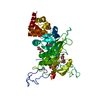 6jwhSC 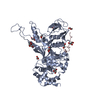 6jwjC S: Starting model for refinement C: citing same article ( |
|---|---|
| Similar structure data |
- Links
Links
- Assembly
Assembly
| Deposited unit | 
| |||||||||||||||||||||||||||||||||||||||||||||||||||||||||||||||||||
|---|---|---|---|---|---|---|---|---|---|---|---|---|---|---|---|---|---|---|---|---|---|---|---|---|---|---|---|---|---|---|---|---|---|---|---|---|---|---|---|---|---|---|---|---|---|---|---|---|---|---|---|---|---|---|---|---|---|---|---|---|---|---|---|---|---|---|---|---|
| 1 | 
| |||||||||||||||||||||||||||||||||||||||||||||||||||||||||||||||||||
| 2 | 
| |||||||||||||||||||||||||||||||||||||||||||||||||||||||||||||||||||
| Unit cell |
| |||||||||||||||||||||||||||||||||||||||||||||||||||||||||||||||||||
| Noncrystallographic symmetry (NCS) | NCS domain:
NCS domain segments:
NCS ensembles :
|
- Components
Components
-Protein , 2 types, 4 molecules IGAE
| #1: Protein | Mass: 8623.726 Da / Num. of mol.: 2 Source method: isolated from a genetically manipulated source Source: (gene. exp.)   Mus musculus (house mouse) / Gene: Ubc, EG216818 / Production host: Mus musculus (house mouse) / Gene: Ubc, EG216818 / Production host:   Escherichia coli (E. coli) / References: UniProt: A5JUZ1, UniProt: P62984*PLUS Escherichia coli (E. coli) / References: UniProt: A5JUZ1, UniProt: P62984*PLUS#2: Protein | Mass: 53939.531 Da / Num. of mol.: 2 Source method: isolated from a genetically manipulated source Source: (gene. exp.)   Saccharomyces cerevisiae S288c (yeast) / Gene: NPL4, HRD4, YBR170C, YBR1231 / Production host: Saccharomyces cerevisiae S288c (yeast) / Gene: NPL4, HRD4, YBR170C, YBR1231 / Production host:   Escherichia coli (E. coli) / References: UniProt: P33755 Escherichia coli (E. coli) / References: UniProt: P33755 |
|---|
-Sugars , 1 types, 14 molecules
| #3: Polysaccharide | alpha-D-glucopyranose-(1-1)-alpha-D-glucopyranose / trehalose /  |
|---|
-Non-polymers , 3 types, 183 molecules 
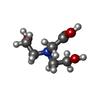



| #4: Chemical | ChemComp-ZN / #5: Chemical | ChemComp-BCN /  Bicine Bicine#6: Water | ChemComp-HOH / |  Water Water |
|---|
-Details
| Has ligand of interest | N |
|---|
-Experimental details
-Experiment
| Experiment | Method:  X-RAY DIFFRACTION / Number of used crystals: 1 X-RAY DIFFRACTION / Number of used crystals: 1 |
|---|
- Sample preparation
Sample preparation
| Crystal | Density Matthews: 3.49 Å3/Da / Density % sol: 64.71 % |
|---|---|
Crystal grow | Temperature: 293 K / Method: vapor diffusion, sitting drop / pH: 6.5 Details: 100mM Bicine-NaOH (pH 6.5), 18% PEG 3350, 200mM lithium sulfate |
-Data collection
| Diffraction | Mean temperature: 100 K / Serial crystal experiment: N |
|---|---|
| Diffraction source | Source:  SYNCHROTRON / Site: SYNCHROTRON / Site:  SPring-8 SPring-8  / Beamline: BL41XU / Wavelength: 0.97904 Å / Beamline: BL41XU / Wavelength: 0.97904 Å |
| Detector | Type: DECTRIS PILATUS3 S 6M / Detector: PIXEL / Date: Dec 1, 2016 |
| Radiation | Protocol: SINGLE WAVELENGTH / Monochromatic (M) / Laue (L): M / Scattering type: x-ray |
| Radiation wavelength | Wavelength : 0.97904 Å / Relative weight: 1 : 0.97904 Å / Relative weight: 1 |
| Reflection | Resolution: 2.55→50 Å / Num. obs: 55810 / % possible obs: 99.1 % / Redundancy: 19.3 % / Rsym value: 0.252 / Net I/σ(I): 10.3 |
| Reflection shell | Resolution: 2.55→2.58 Å / Redundancy: 6.1 % / Num. unique obs: 2546 / CC1/2: 0.504 / Rsym value: 1.307 / % possible all: 91.3 |
- Processing
Processing
| Software |
| |||||||||||||||||||||||||||||||||||||||||||||||||||||||||||||||||||||||||||||||||||||||||||||||||||||||||||||||||||||||||||||||||||||||||||||||||||
|---|---|---|---|---|---|---|---|---|---|---|---|---|---|---|---|---|---|---|---|---|---|---|---|---|---|---|---|---|---|---|---|---|---|---|---|---|---|---|---|---|---|---|---|---|---|---|---|---|---|---|---|---|---|---|---|---|---|---|---|---|---|---|---|---|---|---|---|---|---|---|---|---|---|---|---|---|---|---|---|---|---|---|---|---|---|---|---|---|---|---|---|---|---|---|---|---|---|---|---|---|---|---|---|---|---|---|---|---|---|---|---|---|---|---|---|---|---|---|---|---|---|---|---|---|---|---|---|---|---|---|---|---|---|---|---|---|---|---|---|---|---|---|---|---|---|---|---|---|
| Refinement | Method to determine structure : :  MOLECULAR REPLACEMENT MOLECULAR REPLACEMENTStarting model: 6JWH Resolution: 2.55→48.99 Å / SU ML: 0.3147 / Cross valid method: FREE R-VALUE / σ(F): 1.36 / Phase error: 24.3071
| |||||||||||||||||||||||||||||||||||||||||||||||||||||||||||||||||||||||||||||||||||||||||||||||||||||||||||||||||||||||||||||||||||||||||||||||||||
| Solvent computation | Shrinkage radii: 0.9 Å / VDW probe radii: 1.11 Å | |||||||||||||||||||||||||||||||||||||||||||||||||||||||||||||||||||||||||||||||||||||||||||||||||||||||||||||||||||||||||||||||||||||||||||||||||||
| Displacement parameters | Biso mean: 58.12 Å2 | |||||||||||||||||||||||||||||||||||||||||||||||||||||||||||||||||||||||||||||||||||||||||||||||||||||||||||||||||||||||||||||||||||||||||||||||||||
| Refinement step | Cycle: LAST / Resolution: 2.55→48.99 Å
| |||||||||||||||||||||||||||||||||||||||||||||||||||||||||||||||||||||||||||||||||||||||||||||||||||||||||||||||||||||||||||||||||||||||||||||||||||
| Refine LS restraints |
| |||||||||||||||||||||||||||||||||||||||||||||||||||||||||||||||||||||||||||||||||||||||||||||||||||||||||||||||||||||||||||||||||||||||||||||||||||
| LS refinement shell |
| |||||||||||||||||||||||||||||||||||||||||||||||||||||||||||||||||||||||||||||||||||||||||||||||||||||||||||||||||||||||||||||||||||||||||||||||||||
| Refinement TLS params. | Method: refined / Origin x: 10.915840126 Å / Origin y: -21.2792471351 Å / Origin z: 28.5387213383 Å
| |||||||||||||||||||||||||||||||||||||||||||||||||||||||||||||||||||||||||||||||||||||||||||||||||||||||||||||||||||||||||||||||||||||||||||||||||||
| Refinement TLS group | Selection details: all |
 Movie
Movie Controller
Controller






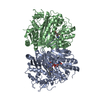
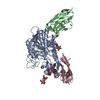
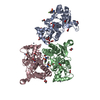




 PDBj
PDBj



























